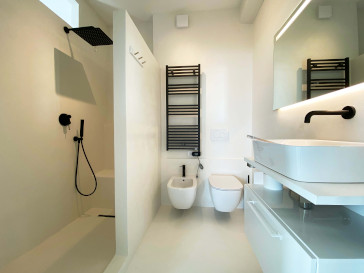Ecobeton microcements, the perfect solution for renovating all your surfaces!
Discover our premium, low-thickness, eco-friendly microcements.

Microbond®
Microbond is our decorative microcement. With just 2 mm, you can cover and renovate internal surfaces, such as floors, walls, kitchen countertops, tiles, bathrooms, showers, etc. Over 300 colours to choose from.

Ercole®
Ercole, the renowned microcement for external use. Strong and resistant, perfect for covering low-thickness driveways, ramps, and garages, but also more refined surfaces such as outdoor patios, verandas, terraces, etc.

Poseidone
Poseidone is the solution we created to overlay swimming pools. Ready to use, it does not require sealers and is perfect for creating a continuous effect on all surfaces in contact with water, such as swimming pools, saunas, steam rooms, etc.
What can you overlay with Ecobeton microcements ?
Seven frequently asked questions about microcement.
Microcement is a material. A microcement floor is a process.
The costs for the products are only a part of the total cost associated with the processing.
The price of each product is easily visible through the price lists and online shops of the various
producers / re-sellers. The final price of the cementitious overlay includes the microcement,
the sealers, ancillary products used before and after the application and mainly the labour cost
of the applicator, which can vary according to the geographical area. We usually tell our customers
that a microcement coating costs roughly the same as high-end quality flooring.
With Microbond® and Ercole®, you can easily overlay vertical and horizontal surfaces with just 2 mm microcement. You can overlay bathrooms, showers, floors, walls, kitchen tops, furniture, sinks, fireplaces, objects, terraces, stairs, outdoor patios, sidewalks and driveways. Concrete, masonry, plasterboard, tiles, wood, stone, veneers and many other materials can all be coated with our microcements; the important thing is that the substrates must be uniform, isolated from moisture and sound. Poseidone is the perfect microcement for swimming pools, saunas, steam rooms and wet areas.
Cement is the binder used to make concrete and mortars. One cannot
use cement itself; it must be mixed with aggregates. Concrete is a
mixture of cement, aggregates like sand and gravel, and admixtures.
Concrete is usually cast with a minimum thickness of 10 cm.
Microcement is a low-thickness overlay, usually 1 to 3 millimetres,
that reproduces the look and feel of the concrete.
One can obtain microcement using resin as a binder and adding cement and fine aggregates. This product class is usually made of two components: a liquid part (resin) and a powder. The other system uses cement as the binder, so it's technically a mortar. This latter product is commonly named cementitious overlay (or Microcement): it is a single component and is generally more resistant and durable.
Applying microcement can also be done by yourself. Many did it successfully.
Like all crafts, knowing what you will face and how to do a proper job is necessary before proceeding.
For example, one should carefully evaluate the support and possibly take remedial steps for the success of
the cementitious overlay. For this reason, we usually recommend the intervention of a trained professional.
For those wishing to experiment at do-it-yourself application, we have drawn up an
Online Application Manual
and Training Courses.
You can also take a look at our tutorial videos on Youtube.
Microcement is a naturally look porous material, so it's subject to dirt retention and staining. One should always protect the cementitious overlay with a transparent clear sealer, at least on floors. Our sealers, such as Cerbero Base, Cerbero WP, Cerbero Sealer and GiGi Sealer, allow the microcement coating to become waterproof, scratch resistant and easier to clean.
The durability of microcement highly depends on the environmental condition of use. Generally, we expect our microcement last as long as a concrete floor. We should remember that it is a low-thickness overlay so it will need more frequent maintenance in an environment with high wearing stress. In mild-stress conditions, such as domestic or commercial floors, we got now a successful track record of more than 20 years without any issues. It's essential, however, to observe direction on daily maintenance and to refresh the protective transparent sealer when needed.
Would you like more information about microcement overlay?
Guides and resources about Ecobeton microcement.
Color Formulas
Choose and order your favorite color for Ecobeton microcements or take a look at the digital Color Gallery.
Go to
Ecobeton Wiki
A useful set of manuals and advice on how to best apply and manage our microcements.
Go to
Builder Notes
Our blog. Useful articles to learn more about the Ecobeton world and the information we want to share.










